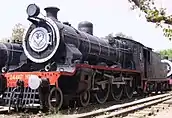| BNR Class P | |||||||||||||||||||||||||||||||||||||
|---|---|---|---|---|---|---|---|---|---|---|---|---|---|---|---|---|---|---|---|---|---|---|---|---|---|---|---|---|---|---|---|---|---|---|---|---|---|
| |||||||||||||||||||||||||||||||||||||
| |||||||||||||||||||||||||||||||||||||
| |||||||||||||||||||||||||||||||||||||
| |||||||||||||||||||||||||||||||||||||
The Bengal Nagpur Railway class P was a class of four 4-8-2+2-8-4 (“Double Mountain”) Garratt locomotives. It was developed from BNR class N and BNR class NM. The Anuppur-Chirmiri section had severe curves and it needed an engine with a trailing bogie. Its boiler was slightly enlarged similar to the NM.
It could haul 1,500 long tons (1,500 t) load up a 1 in 91 gradient.[1]
Technical specifications
| Boiler diameter | 7 ft 1+13⁄16 in (2.180 m) |
| Heating area in firebox | 330 sq ft (31 m2) |
| Boiler area | 3,120 sq ft (290 m2) |
| Adhesive weight | 136 tonnes |
| Maximum train load | 3165 tonnes on level track |
References
- ↑ "5Brinkster". Archived from the original on 2013-10-23.
This article is issued from Wikipedia. The text is licensed under Creative Commons - Attribution - Sharealike. Additional terms may apply for the media files.



